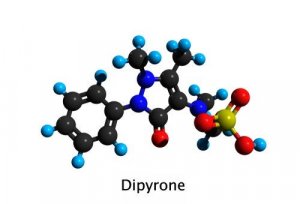The Characteristics and Uses of Novalgin

Novalgin is a drug composed of metamizole or dipyrone. It belongs to the pyrazolone group and has analgesic and antipyretic effects. However, Novalgin also has less powerful anti-inflammatory and spasmolytic properties. In this article you can discover the characteristics and uses of Novalgin.
How Novalgin works

Like all other medicines of the same group, dipyrone or metamizole acts by inhibiting the action of cyclo-oxygenase. Therefore, it inhibits prostaglandin synthesis thanks to its pain-relieving and antipyretic properties.
However, despite this and despite the fact that its metabolites are also active and inhibit prostaglandin synthesis, its anti-inflammatory activity isn’t high.
Furthermore, metamizole relaxes and reduces the activity of the gastrointestinal and uterine smooth muscle. Dipyrone or metamizole can be administered orally, intramuscularly, or intravenously.
The liver rapidly metabolizes Novalgin. There, it transforms into active metabolites that are excreted through the urine.
Uses of Novalgin
Novalgin is used to treat post-traumatic or post-operative moderate or severe pain and spasms. Doctors also prescribe it in cases of a high fever that doesn’t respond to other measures or antipyretic drugs.
You may also enjoy the following article: The Common Classification of Painkillers
Doses and contraindications

Parenteral administration is associated with an increased risk of anaphylactic reactions. To treat fever in children, doctors may indicate a dose of 10 mg/kg of body weight.
The pain-relieving and fever-reducing effects manifest 30 to 60 minutes after administration. Doctors must carefully monitor parenteral doses of over 1 g due to the risk of hypotension.
Experts also recommend diabetics to take tablets or drops instead of syrup. In addition, patients with kidney or liver failure should avoid taking higher doses.
Moreover, regarding contraindications, Novalgin shouldn’t be used in the following situations:
- Hypersensitivity to pyrazolones
- Acute or chronic kidney or liver failure
- Blood dyscrasia
- Active duodenal ulcer
- Heart failure
- Pregnant and lactating women
Furthermore, doctors should hematologically evaluate their patients before treatment and periodically during treatment.
Adverse reactions
Metamizole or dipyrone is a painkiller that, due to its toxic effects, especially due to its risk of agranulocytosis, was removed from the market in many countries. Available information indicates that its use results in severe hypersensitivity reactions. These include:
- Agranulocytosis. Although it’s not very common, it’s a severe, and sometimes irreversible, reaction. However, even though its origin is unknown, it’s an immunological reaction.
- Shock. Another severe hypersensitivity reaction. Its symptoms are itching, cold sweat, drowsiness, nausea, shortness of breath, and skin discoloration.
Agranulocytosis and shock put the patient’s life at risk and require them to stop treatment. In these cases, patients require immediate medical attention.
Furthermore, the patient may suffer from skin-associated hypersensitivity reactions, especially in the ocular mucous membranes and the nasopharyngeal region. Other Novalgin reactions include leukopenia, thrombocytopenia, and hemolytic anemia.
Recommendations to healthcare professionals

The Spanish Agency of Medicines and Medical Devices (AEMPS) analyzed the situation of metamizole in Spain regarding cases of agranulocytosis. For this reason, it insists that people remember that it’s a prescription drug. It also gave the following recommendations to healthcare professionals:
- Use metamizole only for short-term treatments of a maximum of seven days.
- Only use this drug when it fit its approved recommendations, and the minimum effective dose.
However, if longer treatment is necessary, you’ll require periodic hematological evaluations, including blood differential. Don’t prescribe this drug to patients that you can’t evaluate.
Discover more here: Tips that May Help to Reduce a Fever Naturally
Conclusion
Before prescribing Novalgin, doctors should take a detailed medical history. In addition, they should avoid prescribing it to patients with a history of hypersensitivity or hematological reactions to this drug. We hope this article on the uses of Novalgin has been useful for you.
All cited sources were thoroughly reviewed by our team to ensure their quality, reliability, currency, and validity. The bibliography of this article was considered reliable and of academic or scientific accuracy.
- AEMPS. Ficha Técnica (Metamizol) [Internet]. 2021 [Consultado: 28-12-2021]. URL disponible en: https://cima.aemps.es/cima/pdfs/es/ft/63430/63430_ft.pdf.
- Escobar, W., Ramirez, K., Avila, C., Limongi, R., Vanegas, H., & Vazquez, E. (2012). Metamizol, a non-opioid analgesic, acts via endocannabinoids in the PAG-RVM axis during inflammation in rats. European Journal of Pain. https://doi.org/10.1002/j.1532-2149.2011.00057.x.
- Grossman, R., Ram, Z., Perel, A., Yusim, Y., Zaslansky, R., & Berkenstadt, H. (2007). Control of postopertive pain after awake craniotomy with local intradermal analgesia and metamizol. Israel Medical Association Journal.
- Güttler, K. (2015). Metamizol. Schmerz. https://doi.org/10.1007/s00482-015-1520-0.
- Davrieux Mylene, Gutiérrez Stella, Marín Daniel, Pier Daniel, Pais Tito. Agranulocitosis por dipirona: a propósito de un caso clínico. Arch. Pediatr. Urug. [Internet]. 2007 Mar [citado 2022 Nov 02] ; 78( 1 ): 35-40. Disponible en: http://www.scielo.edu.uy/scielo.php?script=sci_arttext&pid=S1688-12492007000100007&lng=es.
- Machado-Alba J, et al. Reacción de anafilaxia grave por dipirona sin antecedente de hipersensibilidad. Informe de caso. Revista Colombiana de Anestesiología 2017;45(S1):8-11. Disponible en: https://www.elsevier.es/es-revista-revista-colombiana-anestesiologia-341-articulo-reaccion-anafilaxia-grave-por-dipirona-S012033471600006X.
- Gaviria, J. Insuficiencia cardíaca. Clínica Universidad de Navarra. Disponible en: https://www.cun.es/enfermedades-tratamientos/enfermedades/insuficiencia-cardiaca
- Agencia Española de Medicamentos y Productos Sanitarios (AEMPS). METAMIZOL Y RIESGO DE AGRANULOCITOSIS (2018). Disponible en:https://www.aemps.gob.es/informa/notasInformativas/medicamentosUsoHumano/seguridad/2018/docs/NI_MUH_FV-15-2018-metamizol-agranulocitosis.pdf
- Gallardo, M. (2013). LA PRESCRIPCIÓN DE MEDICAMENTOS CON REGISTRO DE SU INDICACIÓN TERAPÉUTICA. Boletín Farmacoterapéutico de Castilla-La Mancha. Disponible en: https://sanidad.castillalamancha.es/sites/sescam.castillalamancha.es/files/documentos/farmacia/3.boletin_prescripcion_de_medicamentos.pdf
This text is provided for informational purposes only and does not replace consultation with a professional. If in doubt, consult your specialist.








